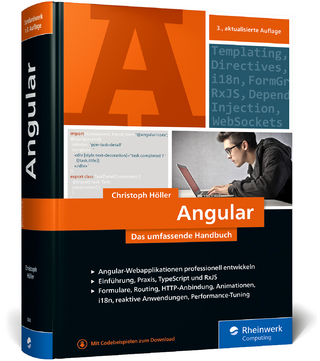
Mastering Voice Interfaces
Apress (Verlag)
978-1-4842-7004-2 (ISBN)
We start with an overview of how humans and machines produce and process conversational speech, explaining how they differ from each other and from other modalities. This is the background you need to understand the consequences of each design and implementation choice as we dive into the core principles of voice interface design. We walk you through many design and development techniques, including ones that some view as advanced, but that you can implement today. We use the Google development platform and Python, but our goal is to explain the reasons behind each technique such that you can take what you learn and implement it on any platform.
Readers of Mastering Voice Interfaces will come away with a solid understanding of what makes voice interfaces special, learn the core voice design principles for building great voice apps, and how to actually implement those principles to create robust apps. We’ve learned during many years in the voice industry that the most successful solutions are created by those who understand both the human and the technology sides of speech, and that both sides affect design and development. Because we focus on developing task-oriented voice apps for real usersin the real world, you’ll learn how to take your voice apps from idea through scoping, design, development, rollout, and post-deployment performance improvements, all illustrated with examples from our own voice industry experiences.
What You Will Learn
Create truly great voice apps that users will love and trust
See how voice differs from other input and output modalities, and why that matters
Discover best practices for designing conversational voice-first applications, and the consequences of design and implementation choices
Implement advanced voice designs, with real-world examples you can use immediately.
Verify that your app is performing well, and what to change if it doesn't
Who This Book Is For
Anyone curious about the real how’s and why’s of voice interface design and development. In particular, it's aimed at teams of developers, designers, and product owners who need a shared understanding of how to create successful voice interfaces using today's technology. We expect readers to have had some exposure to voice apps, at least as users.
Ann Thymé-Gobbel's career has focused on how people use speech and natural language to communicate with each other and with technology. After completing her PhD in cognitive science and linguistics from UC San Diego, she's held a broad set of voice-related UI/UX design roles in both large corporations and small start-ups, working with diverse teams in product development, client project engagements, and R&D. Her past work includes design, data analysis and establishing best practices at Nuance, voice design for mobile and in-home devices at Amazon Lab 126, and creating natural language conversations for multimodal healthcare apps at 22otters. Her research has covered automatic language detection, error correction, and discourse structure. She is currently Director of UI/UX Design at Loose Cannon Systems, the team bringing to market Milo, a handsfree wearable communicator. Ann never stops doing research: she collects and analyzes data at every opportunity and enjoys sharing herfindings with others, having presented and taught at conferences internationally. Charles Jankowski has over 30 years’ experience in industry and academia developing applications and algorithms for real-world users incorporating advanced speech recognition, speaker verification, and natural language technologies. He has used state-of-the-art machine learning processes and techniques for data analysis, performance optimization, and algorithm development. Charles has highly in-depth technical experience with state-of-the-art technologies, effective management of cross-functional teams for all facets of application deployment, and outstanding relationships with clients. Currently, he is Director of NLP at Brain Technologies, creating the Natural iOS application with which you can “Say it and Get it.” Previously he was Director of NLP and Robotics at CloudMinds, Director of Speech and Natural Language at 22otters, Senior Speech Scientist at Performance Technology Partners, and Director of Professional Services at Nuance. He has also been an independent consultant. Charles holds S.B., S.M., and Ph.D. degrees from MIT, all in electrical engineering.
PART 1 – Voice System Foundations.- Chapter 1: Say Hello to Voice Systems.- Chapter 2: Keeping Voice in Mind.- Chapter 3: Running a Voice Implementation—and Noticing Issues.- PART 2 – Planning Voice System Interactions.- Chapter 4: Defining your Vision: Building What, How, and Why for Whom.- Chapter 5: From Discovery to UX and UI Design: Tools of the Voice-First Trade.- PART 3 – Building Voice System Interactions.- Chapter 6: Applying Human 'Rules of Dialog' to Reach Conversation Resolution.- Chapter 7: Resolving Incomplete Requests Through Disambiguation.- Chapter 8: Conveying Reassurance with Confidence and Confirmation.- Chapter 9: Helping Users Succeed Through Consistency.- Chapter 10: Creating Robust Coverage for Speech-to-Text Resolution.- Chapter 11: Reaching Understanding Through Parsing and Intent Resolution.- Chapter 12: Applying Accuracy Strategies to Avoid Misunderstandings.- Chapter 13: Choosing Strategies to Recover from Miscommunication.-Chapter 14: Using Context and Data to Create Smarter Conversations.- Chapter 15: Creating Secure Personalized Experiences.- PART 4 – Verifying and Deploying Voice System Interactions.- Chapter 16: Testing and Measuring Performance in Voice Systems.- Chapter 17: Tuning and Deploying Voice Systems.
| Erscheinungsdatum | 07.06.2021 |
|---|---|
| Zusatzinfo | 143 Illustrations, black and white; XXIX, 689 p. 143 illus. |
| Verlagsort | Berkley |
| Sprache | englisch |
| Maße | 178 x 254 mm |
| Themenwelt | Mathematik / Informatik ► Informatik ► Programmiersprachen / -werkzeuge |
| Informatik ► Software Entwicklung ► Mobile- / App-Entwicklung | |
| Informatik ► Theorie / Studium ► Künstliche Intelligenz / Robotik | |
| Schlagworte | Artificial Intelligence • Conversational Interfaces • Intelligent Voice Assistant • Natural Language Processing • Natural language understanding • Speech Technology • Voice Application System Development • Voice First • Voice Forward • Voice Only • Voice User Interface Design • Voice User Interface Design |
| ISBN-10 | 1-4842-7004-5 / 1484270045 |
| ISBN-13 | 978-1-4842-7004-2 / 9781484270042 |
| Zustand | Neuware |
| Haben Sie eine Frage zum Produkt? |
aus dem Bereich


